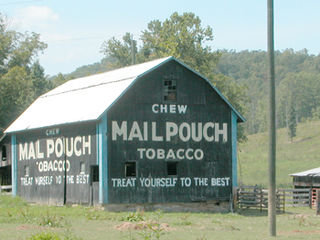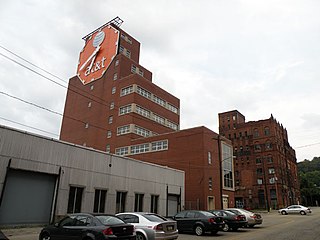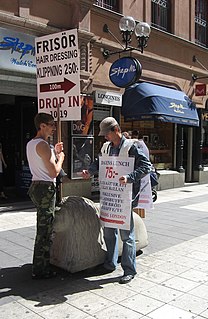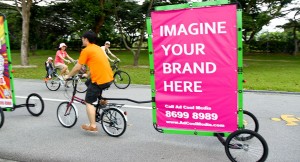 W
WA barn advertisement is an outdoor advertisement painted onto the exterior of a roadside barn. Advertisers take advantage of the barns' prominence in rural landscapes, paying their owners for the right to paint and maintain logos and slogans on them. Painters of barn advertisements and other murals are known as "wall dogs". Once a common form of billboard advertising in the Midwestern and Southeastern United States during the early– to mid–20th century, barn advertisements have faded into obscurity, as many of these rural ghost signs fall into disrepair, along with the structures that bear them.
 W
WThe Bekins Storage Co. Roof Sign is a rooftop sign in Pasadena, California, which originally advertised the Bekins Storage Company. The sign was erected in 1926 and converted to a neon sign in 1929. Located 60 feet (18 m) above the ground at the top of the Bekins Storage Company building, the sign was designed to attract the attention of drivers of Fair Oaks Avenue, which was part of U.S. Route 66 from 1926 until 1940. The sign is now the only surviving large rooftop sign from before World War II in Pasadena, and one of few remaining signs of any type from the period. Similar signs are now banned by Pasadena law, though signs from before 1960 are exempted and listed on a city register. The sign was later renovated to promote the A. American Storage Co. and now advertises Public Storage.
 W
WA billboard is a large outdoor advertising structure, typically found in high-traffic areas such as alongside busy roads. Billboards present large advertisements to passing pedestrians and drivers. Typically showing witty slogans and distinctive visuals, billboards are highly visible in the top designated market areas.
 W
WA billboard bicycle is a type of mobile advertising in which a bike tows a billboard with an advertising message. Gary Saunders of Queens, NY, New York began the billboard bicycle concept in 1997. His billboard bicycle was geared toward messenger bikes and measured 12" by 18".
 W
WThe Coca-Cola Sign is an electro-kinetic sculpture on the Two Times Square building in Times Square, Manhattan, New York City. The current sign, installed in 2017, stands at 68 ft. tall and 42 ft. wide, and is the latest in a line of Coca-Cola Times Square signs dating back to 1920.
 W
WThe Dallas Waterfall Billboard is a Dallas, Texas landmark built in 1962. It is located at 3303 Harry Hines Blvd, Dallas, TX 75201 along a small park known as Goat Hill, a 0.85 acre park in the Katy Trail easement. The sign is visible from I-35 highway while driving to downtown Dallas. It is currently owned by Clear Channel Communications and leased to Coors Brewing Company.
 W
WA digital billboard is a billboard that displays digital images that are changed by a computer every few seconds. Digital billboards are primarily used for advertising, but they can also serve public service purposes.
 W
WLocated on the Duquesne Brewing Company building in Pittsburgh, Pennsylvania, the Duquesne Brewery Clock was the largest single-face clock in the world when it was installed in 1933. Over the years its face has been used to advertise numerous brands, beginning with Coca-Cola.
 W
WThe Hollywood Sign is an American landmark and cultural icon overlooking Hollywood, Los Angeles, California. It is situated on Mount Lee, in the Hollywood Hills area of the Santa Monica Mountains. Spelled out in 45 ft (13.7 m)-tall white capital letters and is 350 feet long, it was originally created in 1923 as a temporary advertisement for a local real estate development, but due to increasing recognition, the sign was left up.
 W
WA human billboard is someone who applies an advertisement on his or her person. Most commonly, this means holding or wearing a sign of some sort, but also may include wearing advertising as clothing or in extreme cases, having advertising tattooed on the body. Sign holders are known as human directionals in the advertising industry, or colloquially as sign walkers, sign wavers, sign twirlers or sandwich men. Frequently, they will spin or dance or wear costumes with the promotional sign in order to attract attention.
 W
WThe Last Billboard is a public art billboard in Pittsburgh, Pennsylvania. The art piece consists of a 12-feet-by-36-feet steel frame billboard on which letters can be arranged. Each month, artists are solicited to place a message on the billboard. It is curated by Jon Rubin. The billboard is located at the intersection of Highland Avenue and Baum Boulevard in the East Liberty neighborhood, above what was originally the building for Waffle Shop: A Reality Show, a restaurant that was also conceptualized by Jon Rubin.
 W
WThe Letras de Ponce is a famous landmark in Barrio Sabanetas in Ponce, Puerto Rico, located southbound on PR-52 at the intersection with PR-10. The iconic monument consists of five letters that spell the name of the city P-O-N-C-E in 20-foot high (6.1 m) by 18-foot wide (5.5 m) by 12-foot deep (3.7 m) red and black letters. The letters, and its resulting sign, were designed by Carlos Rivera Villafañe, a sculptor from Ponce. The landmark is said to be "known to every Puerto Rican."
 W
WA mobile billboard also known as "digital billboard trucks" is, a device used for advertising on the sides of a truck or trailer that is typically mobile. Mobile billboards are a form of out-of-home advertising (OOH); radio, static billboards, and mall/airport advertising fall into this same category. Using a mobile billboard for advertising is an advertising niche called mobile outdoor advertising.
 W
WThe Paddy Power Cleeve Hill sign was officially the world's largest free standing advertising board in the world until 2010. Situated in Cheltenham in the United Kingdom the board was built by Bristol-based Utopium Lighting to advertise the Paddy Power betting company on the Cheltenham Gold Cup race week. It stood 50 feet high, stretched 270 feet wide and cost tens of thousands of pounds and 1000 man hours to create. This is bigger than the Hollywood sign, which is 45 feet tall.
The Pelaco Sign is a heritage-listed neon sign located in the inner Melbourne suburb of Richmond. It was erected in 1939 as an advertisement for local shirt manufacturer Pelaco.
 W
WA sandwich board is a type of advertisement tool composed of two boards with a message or graphic on it and being either carried by a person, with one board in front and one behind in a triangle shape, hinged along the top, creating a "sandwich" effect; or set up next to a store advertising its goods. In this way, the advertising message can be read on both sides interchangeably.
 W
WA Trivision, also called three-message sign, is a billboard/sign that consists of triangular prisms placed inside a frame. The prisms rotate 120°, each showing a new message of advertisement and/or information. As implied, three individual images, or messages, can be displayed on a Trivision.
 W
WThe Uncle Sam billboard is a billboard directly adjacent to the northbound lanes of Interstate 5 near Chehalis, Washington, in the United States.